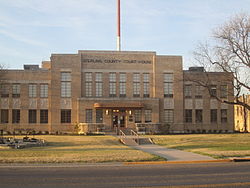Sterling County, Texas
| Sterling County, Texas | |
|---|---|

Sterling County Court House off U.S. Highway 87 in Sterling City
|
|
 Location in the U.S. state of Texas |
|
 Texas's location in the U.S. |
|
| Founded | 1891 |
| Seat | Sterling City |
| Largest city | Sterling City |
| Area | |
| • Total | 924 sq mi (2,393 km2) |
| • Land | 923 sq mi (2,391 km2) |
| • Water | 0.1 sq mi (0 km2), 0.01% |
| Population | |
| • (2010) | 1,143 |
| • Density | 1.2/sq mi (0/km²) |
| Congressional district | 11th |
| Time zone | Central: UTC-6/-5 |
| Website | www |
Sterling County is a county located on the Edwards Plateau in the U.S. state of Texas. As of the 2010 census, its population was 1,143, making it the ninth-least populous county in Texas. Its county seat is Sterling City. The county is named for W. S. Sterling, an early settler in the area. Sterling County is one of 30 prohibition, or entirely dry, counties in the state of Texas.
Original native Plains Indians included Comanche, Lipan Apache, Kiowa, and Kickapoo.
The region had a number of violent encounters between the Comanche, local ranchmen, and Texas Rangers. A deadly skirmish occurred in the 1870s between area ranchmen and the Comanche on the Lacy Creek on the present day Campstool Ranch. “The Fight at Live Oak Mott” is an account of the events as written by W.K. Kellis, in the Sterling City News-Record, and later published in Frontier Times by J. Marvin Hunter. In 1879, the last significant battle between the Texas Rangers and the Comanche occurred on the "U" Ranch, at the time the ranch was owned by Earnest and Holland. The Comanches, led by the Quahada chief named Black Horse, left Fort Sill, Oklahoma, on May 29 with a group of 19 braves in a search for buffalo, and by June 29, they had yet to find any buffalo, so they killed a horse on the "U" Ranch, near the headwaters of the Concho River in Howard County, and an ensuing battle with the Texas Rangers soon followed. (I claim that this entire "raid" was probably not by Comanches—possibly by Apaches—but most likely non-Indian horse thieves. It was a cover-up of the mysterious killing of a Texas Ranger. And for the first time in Ranger history several of them were fired for cowardice. --Doyle Phillips)
...
Wikipedia
